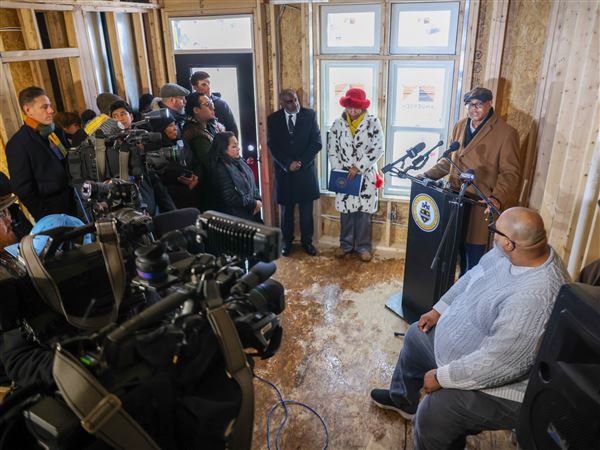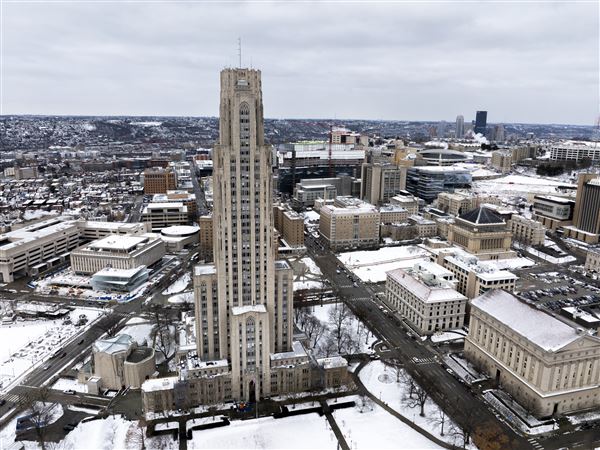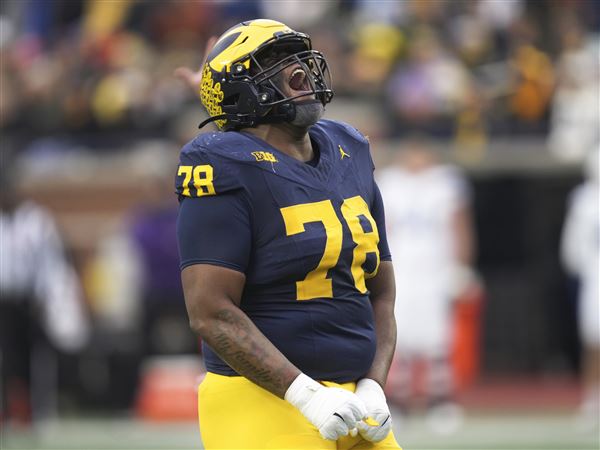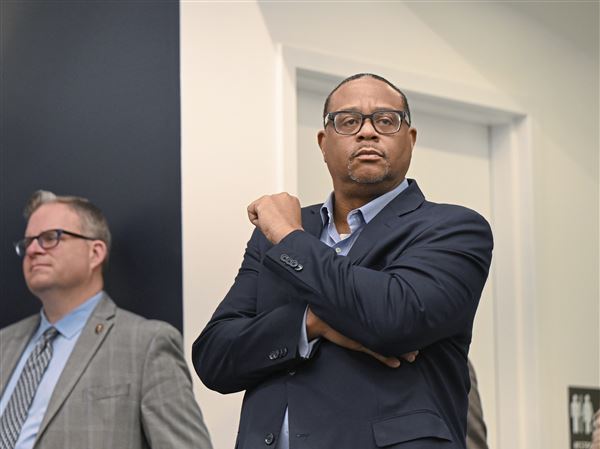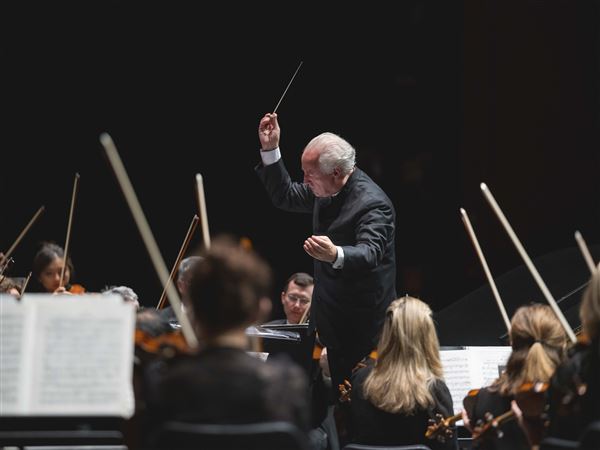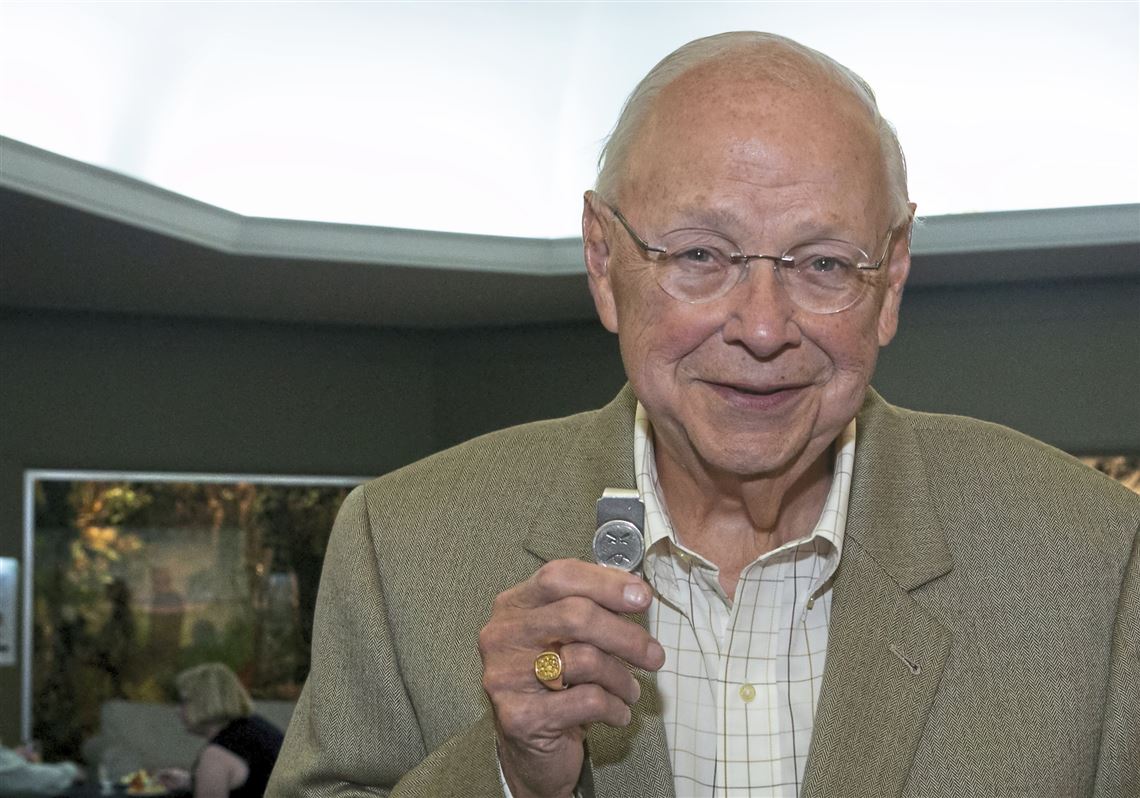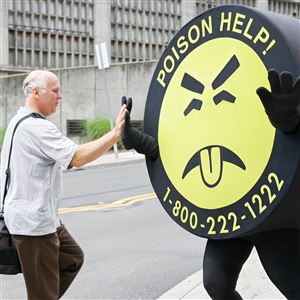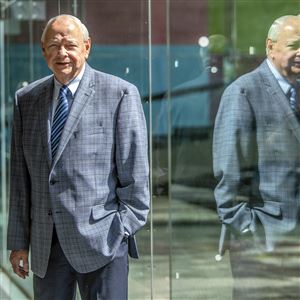Dr. Richard W. Moriarty, the Lawrenceville native who built the Pittsburgh Poison Center and created its beloved mascot Mr. Yuk, has died. He was 83.
The retired pediatrician had undergone mitral valve replacement surgery nearly three months ago and, after three total procedures and spending most of the following weeks in intensive care, he passed away early Thursday at UPMC Shadyside, his husband, Dave Hairhoger, said.
“There’s a lot to be said about him,” Mr. Hairhoger, 70, said.
On the professional front, of course, the headline-grabber was Mr. Yuk. The green guy, however, was very much in Dr. Moriarty’s personal life, down to the treasured Mr. Yuk money clip he received years ago as a gift.
Across Dr. Moriarty’s long hospital stay, Mr. Hairhoger affixed circular Yuk stickers on hospital workers — “Anyone who entered his room was tagged with a Mr. Yuk sticker” — and occasionally asked folks, “Have you been Yukked?”
Though Dr. Moriarty could no longer speak following a tracheostomy, Mr. Hairhoger said his expressive eyerolls and grins communicated all they needed to about his repeated joke.
The two married in 2014, Mr. Hairhoger said, “Only because all of our heterosexual friends said to us, ‘When are you going to get married?’” But it was a mere formality.
“Richard and I, we never fell in love, because the moment we met, we were in love with each other,” he said.
The genesis of Mr. Yuk dates back to Dr. Moriarty’s days as an intern at Children’s Hospital of Pittsburgh, at a time when, “Whoever picked [the phone] up was suddenly the Poison Center,” Dr. Moriarty told the Post-Gazette during a May interview, from the back patio of his Herr’s Island rowhouse. That struck Dr. Moriarty as “ridiculous,” and he set his organizational brain to fixing the problem.
He had a “real ability to assess the problem and find a simple solution, and scale it,” said Pittsburgh Public Theater artistic director Marya Sea Kaminski, who worked with Dr. Moriarty on PPT’s board.
Dr. Moriarty revamped poison control as attempts to standardize poison centers were relatively new. A national poison center, now known as America’s Poison Centers, didn’t exist until 1958.
In the late 1960s, Dr. Moriarty, then chief resident at Children’s, was empowered to modernize the Pittsburgh Poison Center. He tracked down seed money — $250,000 from Frances Scaife at the Allegheny Foundation, he noted — and got to work.
It is out of that quarter-million that Mr. Yuk was born, but focusing on that tiny celebrity doesn’t tell the complete story of Dr. Moriarty’s accomplishments with the Poison Center. In addition to ensuring it had a full-time staff of employees experienced in toxicology, nursing or another related discipline, he kickstarted data collecting for the region.
Systematic data collection at the time was nonexistent, said Dr. Alvin Bronstein, who helped create the national poison database, in a July interview.
“Physicians like Dr. Moriarty really led the way in putting some logic to poison treatment,” Dr. Bronstein said.
As for Mr. Yuk, Dr. Moriarty gave much of the credit to kids participating in the focus groups used in the mascot’s development.
Following the youngsters’ cues — their responses to the angry face, the fluorescent green color — Mr. Yuk was born.
Basically, Dr. Moriarty said, “the Mr. Yuk symbol was designed by kids for kids.”
The Mr. Yuk poison awareness campaign launched in 1971 and, all these years later, Pittsburgh Poison Center is still sending the signature stickers “all over the place,” said the center’s director, Amanda Korenoski.
Mr. Yuk isn’t just Pittsburgh famous: The chartreuse-colored avatar for poison control continues to tell kids to stay away from toxic substances and is utilized by other poison centers, including Seattle’s.
Dr. Moriarty, also a onetime associate clinical professor of pediatrics at Pitt, “truly had a passion not only for Mr. Yuk, but for poison awareness overall,” Ms. Korenoski said, adding that he remained interested in what the center was doing — and happy that his creation was still relevant.
The city of Pittsburgh issued a proclamation on Oct. 1, 2019, three days before his 80th birthday, in honor of his many accomplishments.
About Mr. Yuk, Mr. Hairhoger said, his husband would often say, “‘Yeah I brainwashed a lot of people,’” followed by his signature sustained laugh.
Aside from a passion for travel — “We traveled the world,” Mr. Hairhoger said — Dr. Moriarty remained in Pittsburgh his entire life. He grew up in Lawrenceville — the true Lawrenceville, he was quick to point out, in what we now know as Central Lawrenceville — and ended up residing for 25-some years just blocks away on Herr’s Island.
“I had very nice job offers, but I wanted to stay here. I’m a hokey guy. I like this place,” Dr. Moriarty said, his and Mr. Hairhoger’s cherished miniature Australian shepherd Bonnie close by.
After ticking off numerous of Dr. Moriarty’s professional accomplishments, longtime friend Dr. Harvey Rubin pointed out that his colleague was invested in his hometown. The two go back to 1966, when they were interns together at Children’s. (Years later, Dr. Moriarty even played Cupid. “Richard is kind of responsible for me marrying Lynn,” Dr. Rubin said of his wife. “He said, ‘You love that woman, why don’t you marry her?’”)
Dr. Moriarty’s commitment to Pittsburgh was also documented through his philanthropy, particularly via his contributions to the Carnegie Museum of Natural History and Pittsburgh Public Theater. In addition to being generous with his time — he was a board member at both — he also donated and helped fund raise. He underwrote many PPT actors, Mr. Hairhoger said, and was a big supporter of its annual Shakespeare program for kids.
“He was a total champion of this organization. He is one of the reasons that we’re here,” Ms. Kaminski said. “I cannot say how deeply he will be missed.”
Dr. Moriarty underwrote a number of productions, including being one of the primary supporters for the upcoming premiere of “Billy Strayhorn: Something to Live For,” which debuts later this month.
“He is individually responsible for bringing so many actors and productions to our stage,” Ms. Kaminski said.
The Carnegie Museum of Natural History connection goes back much further, to a childhood that found the self-described “science nerd” at the museum Saturday mornings for a program an Arsenal Middle School teacher encouraged him to attend.
“I just fell in love,” he said.
Young Richard’s passion for science continued as he attended Pitt’s School of Medicine, launched the modern poison center and, later, went on to run a private pediatric practice. And the museum kept its hold.
“He was such a champion for all of our science, just a bottomless cup of curiosity, and he was a cherished friend to me and to the museum as a whole,” Carnegie Museum of Natural History director Gretchen Baker said.
In 2006, he took the helm of the Carnegie Discoverers, a membership-based program with scientific lectures held monthly except during summertime. Through it, Ms. Baker said, he helped raise $660,000 for the museum, much of which went to research. With the fall Discoverers’ kickoff slated for next week, Ms. Baker noted, Dr. Moriarty had reached out, post-surgery, concerned about who might be able to host it in his stead.
“Even in the hospital he was thinking of us,” she said.
Mr. Hairhoger was with Dr. Moriarty during his final moments, and recalled his final words. “I said to him, ‘Richard, what we had for 30 years is a relationship that anyone would love and cherish.’ And after I said that, the nurse came in and said he had passed.”
In addition to Mr. Hairhoger, Dr. Moriarty is survived by a niece, Amy (Bob) Anderson and nephew Ed (Liz) Moriarty.
Visitation will take place at John A. Freyvogel Sons, 4900 Centre Ave., with date and times to be determined. Memorial donations can be made to the Carnegie Museum of Natural History or Pittsburgh Public Theater.
Polly Higgins: phiggins@post-gazette.com
First Published: September 7, 2023, 10:43 p.m.
Updated: September 8, 2023, 6:39 p.m.
